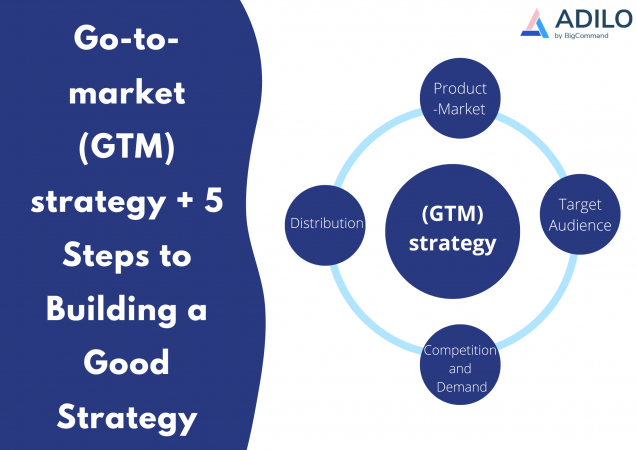Have you ever wondered “What is a go-to-market strategy?”

Go-to-market (GTM) strategy refers to well-thought-out plans or processes necessary to launch a product and persuade people to use it successfully.
A go-to-market (GTM) strategy is an actionable business plan that assists you in identifying your ideal customers, aligning your messaging, and positioning your product for launch. A GTM strategy also ensures that critical business units are on the same page, allowing you to meet market needs and iterate on your product effectively.
A GTM strategy provides the framework for all of your marketing efforts before you even begin directing those marketing assets.
The go-to-market (GTM) strategy is the backbone of any company. It describes not only what your product does but also where it sits in the marketplace and how it is positioned to win market share from the competition.
Of course, a GTM strategy can be an effective tool for more than just a new product introduction. Companies use new GTM strategies for their products when evolving the value proposition or positioning to support new target markets.
GTM is a marketing strategy you want to plan before launching your product or business. It would help if you understood the target audience, competition, and positioning well. Like other marketing strategies, GTM planning can be done before or after the product has been created.

You have a great idea, a superior product, and a proposal to partner your solution with a local business. Now you need to get it off the ground. You’ll want a good plan for “getting to market” — or the process of persuading customers to buy your product and helping them realize its value.
Products can be complex things to launch. There are many elements to consider, and false moves can negatively impact your brand, sales, and company.
When launching a new product, the last thing you want to do is do so without a solid go-to-market strategy. This process is used to launch a product into the market and involves making numerous strategic decisions at each step of the production cycle.
For instance, you can focus your marketing efforts on cold traffic, create a Facebook ad containing your content, and target those likely to share it or include an educational component to familiarize users with how it works.
If you skip any steps in the process or don’t provide value early on, potential customers can lose interest — before ever converting! A go-to-market strategy is an overall marketing plan that’s unique to your new venture and can be used to help it reach profitability more quickly.
When building a new product or launching an upsell campaign, you want to ensure your product is placed in the best possible market for growth. By using the help of a targeting strategy like go-to-market (GTM) analysis, you can avoid making costly mistakes, focus on needs with the highest potential, and inject more focus, relevance, and profitability into every stage of your product’s life cycle.
What is the importance of using Go-to-market (GTM) strategies in your business or brand? Why do companies use them?
There’s nothing worse than creating a fabulous product that customers adore yet getting poor sales because the product is poorly marketed. A go-to-market strategy is a blueprint for engaging customers and increasing demand for your product or service, ultimately leading to positive growth results.
Time is of the essence when building a GTM strategy, so it’s best to start early in the process, so you’re not starting from scratch once your product or service is complete.
GTM describes a movement that moves the customer to the point of conversion or purchase. Put another way; it’s the bit between awareness and action. Your audience needs to be aware of your business, know that you have the answer they are looking for, and then take action on their desire to make a purchase or convert.
Understanding how this process works will help you determine an effective strategy so that customers can be engaged effectively in every buying cycle and move forward with their purchases. A good GTM requires understanding your customer’s journey from awareness to consideration and conversion.
Everyone wants to launch their new product quickly so they can start making money, but it’s important to remember that you’re trying to build a business, not just launch a product. Creating a GTM strategy for every new development will help ensure your success.

Do you know the difference between a Go-to-market (GTM) strategy and a marketing strategy?
A marketing strategy is concerned with how a company can reach out to a specific market over time and deliver on its overall value proposition. A go-to-market strategy aims to figure out how to get new products or services onto the market.
The marketing strategy is long-term and driven by the company, while the product’s go-to-market plan is short-term and operated.
components of a go-to-market strategy

– Product-Market Fit entails defining the problem your product or service intends to solve.
– Target Audience: People with the problems you’re trying to solve make up your target audience, the price they’re willing to pay to solve the problem, and their potential issues and struggles.
– Competition and Demand: who else is offering the service or product you want to launch, and how big is the market demand?
– Distribution: What method will you use for marketing your product or service? Is it better to use a website, an app, or a third-party distributor?
When do you need a go-to-market strategy?
When launching a new or existing product or service to the market, the go-to-market strategy can be used. It can be used for various other purposes, such as taking a current product and launching it into a new market.
5 Steps to building a Go-to-market (GTM) strategy

A well-thought-out go-to-market strategy can help you leverage the power of your customers to boost your bottom line while reducing direct advertising costs. Done right, a GTM strategy can help you develop a pipeline of sales and an arsenal of ideas to keep your brand in front of new customers. But this takes good planning and strategic thinking.
How can you improve your go-to-market strategy? These five steps will assist you in achieving your objective:
Step 1: Create a product that meets people’s needs and solves problems.

There is no right or wrong way to implement a GTM strategy but to succeed; a business must first pick the right product. The next important step is determining the best way to get their product in front of customers.
The third step is finding the right partner or partners to help them move forward in an agile and transparent manner. And the fourth and often most overlooked step is seeing what works and making changes accordingly after launch.
Every successful product launch aims to solve a specific problem. Identify a problem and offer a solution to customers so they will buy your product. Create a product that meets people’s needs, adds value to their needs, and alleviates their pain points. This can be based on a solution to a problem or an enhancement of a current product design.
Step 2: Find out your target market by doing some research.

Good research on go-to-market strategy should conveniently answer the following questions
– What do you intend to sell?
– Who are the people you want to sell your product to?
– How will you establish a relationship with your target audience?
– What is the maximum price point for a solution that your target audience is willing to pay?
This step is crucial because it allows you to learn more about the people most likely to buy your product. During the research phase of your new business, you would naturally gather much data on customers, including their age, gender, education, earnings, and habits, among other things.
But most entrepreneurs additionally use this data to define an ideal customer profile (ICP) and buyer personas to narrow their customer base and define the types of people who make up their target market.
A perfect buyer who fits into the category of customers you want to sell your products to is known as an ideal customer profile (ICP). First, let’s look at the definition of an ICP, also known as a perfect buyer profile.
An ICP is a profile for your ideal client that gives enough details about their problems and goals to help you position yourself as the best fit for them. It would help if you used this to focus on certain types of businesses, demographics, or people with the exact needs you help fulfill. This can range from multiple types of business to even specific ages, genders, or lifestyles.
This is important because too vague of a definition for your ICP will limit who you sell to and don’t. It will also make it harder for you to find the resources or methods to reach those people and market your company to them effectively. The ideal customer profile, or ICP, describes a perfect customer who will buy your products or service.
The ICP is meant to be used as a benchmark for marketing activities; it helps you and your team avoid wasting time and money on people who will never buy from you. An ICP enables you to understand who would be the best target for your outreach campaigns (content marketing) and direct pitches (cold calls or meetings).
A buyer persona is a simplified portrayal of your customers that considers their demographics, ambitions, motivators, and challenges. It assists us in determining how the ideal customer acts and their needs.
We can devise better strategies to engage them with this information. How is this beneficial? It binds marketing together by making it more relevant to our target market. We will be able to create better products and services that they will value and enjoy.
A buyer persona comprises two elements: the demographics and goals of your typical customer (which can be quantified and thus understood) and the subconscious motivations that drive them to achieve these goals. Startups and enterprises have used this concept to guide marketing, product development, and strategy.
Buyer personas are complete and understandable human beings to whom you directly market your services based on what they want and need depending on the stage at which they are within the buying process.
Step 3: Research your competition

The power of understanding your competition – Competitive research is a method of evaluating how well your company and its products or services are performing compared to other companies in your market that sell similar products or services.
Competitive analysis is a valuable tool to aid in a strategic decision-making process that involves examining the current condition of the marketplace, key market trends affecting the overall industry, and potential scenarios for the future. A competitive analysis is one way to get a picture of what is happening in the industry that you are planning to enter.
It may also help you identify the challenges in finding new customers. This process can give you an advantage over your competition and help you make more intelligent, strategic business decisions.
Before launching any product or service, conducting a thorough competitive analysis is critical. This entails researching your competitors, assessing their strengths and weaknesses, and assessing the strengths and weaknesses of their products or services.
To research your competition, you need to search for similar businesses, products, or services to determine what they are doing right and what they are doing wrong. You can also make a product comparison or start an online survey to collect user feedback and create a new promotion campaign.
It’s also a good idea to research direct and indirect competitors. In marketing and sales, direct competition is the rivalry between two companies as they try to acquire a limited number of customers for a product or service.
Direct competition is categorized as “direct” because it occurs face-to-face in its marketplace or market. Indirect marketing competition, on the other hand, takes place in the same market but with different products or services.
Step 4: Make a value matrix and a message that speaks to the customer’s problem.

To begin creating the value matrix, decide where you want to market your product. Do you want a high-end market, or are you looking for a large, mainstream audience? High-end buyers will always find it easier to justify your price, but this comes at the cost of a smaller market.
Ultimately, you will have to decide what is best for your product, but marketing to a larger group also has its benefits.
When creating a value matrix, ensure it is as detailed and encompassing as possible. Include not only the buyer persona’s name and needs but their demographics, current jobs, hobbies, and interests.
Use the marketing message to promote your product and its benefits by describing how it will solve this client’s problems.
Step 5: Test your market using inbound methods, and increase brand awareness and demand generation.

Inbound marketing is a strategy for attracting customers by providing them with relevant content and experiences—and building relationships along the way. Unlike outbound marketing, which bombards your audience with content they don’t always want, inbound marketing builds relationships and solves problems they already have.
Because you’re reaching out to people who are already interested in what you’re offering, inbound marketing is more likely to generate more qualified leads. So creating content that speaks to the problems of your target audience will get you, clients, organically.
It’s time to put your message to the test after you’ve created your value matrix. Begin advertising on marketing platforms with the notes you’ve just made for various audience members.
If you’re running a business that sells products, you’ll want to advertise on Facebook and Instagram. If you’re running a service-based business, then try Twitter and LinkedIn.
The idea is to find the platform that best targets your audience and start advertising there. You’ll need to pay for these ads; however, if you have a solid value proposition, it won’t take long before those ads start paying off.
Now, you can measure the results of your message by looking at how well it performs based on its response rate (how many people click on it) and engagement rate (how many people engage with it). This information will enable you to figure out what works best for each audience and adjust your messaging accordingly.
Please focus on the ads with the highest engagement rates and use them to create content and social media ads targeting those specific audiences once you’ve determined which ones are working best.

Conclusion
If you’re focusing all your efforts on getting the product out there, it might seem the most crucial thing at the time. But building a sustainable business is always more important than quickly launching a single product.
In the long-term, doing that will only hurt you and your company. Start by developing a GTM strategy for each new product you bring to market and save yourself some trouble in the future.
In summary, having a go-to-market strategy for your new product is the difference between success and failure. Businesses are always looking for the next big thing, so if you can deliver that “next big thing” to your clients quickly and efficiently, you’ll have no problem growing your business.
RELATED: A Step-by-step Guide to Micromarketing
You love this Article. Get more Updates via Adilo’s Twitter Page.













